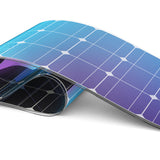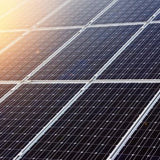Transparent Solar Panels

One of the factors preventing widespread adoption of solar panels is the limited space for installation, particularly in densely populated areas where land and roof space are scarce.
Transparent solar panels could be a potential solution to this issue. Imagine cities where skyscrapers can generate electricity through their glass exteriors. In the U.S alone, transparent solar panels have the potential to provide 40% of the country’s energy demand if applied to every building’s glass surfaces.
In order to create transparent solar panels, you must carefully balance how much light is absorbed, and how much is transmitted. Using small absorbent particles which absorb and redirect non-visible light, transparent solar panels have been created to allow 90% of visible light to pass through, while still generating electricity. There are also semi transparent solar cells using specially designed materials that absorb only a portion of the solar spectrum, transmitting the rest. These devices have transparency of up to 605, but can achieve higher efficiencies.
Whether transparent or semi-transparent, the challenges with developing these photovoltaic devices lies in choosing the right material, and appropriately characterizing both efficiency and transparency simultaneously in outdoor sunlight or under solar simulators.
Can Solar Panels Be Transparent?
The idea of a transparent solar panel may seem counterintuitive. We know that solar panels need to absorb light to generate electricity, but transparency implies that light can pass straight through. However, you can in fact make transparent solar panels!
Transparent solar panels generate electricity using photovoltaic (PV) cells (also known as solar cells). These are similar to the cells that make up traditional solar panels. The difference is in how light is directed within these solar panels.
Traditional solar panels consist of multiple PV cells arranged in a grid pattern. These cells collect solar energy directly from the sun and must be placed at an angle to maximise their exposure to sunlight.
Transparent solar panels, however, are mostly made up of transparent material. This material captures invisible wavelengths of sunlight and redirect them towards thin strips of PV cells positioned at the panel's edges. This allows transparent solar panels to be placed vertically, expanding the range of potential installation locations.
How Do Transparent Solar Panels Work?
Visible light (the light that we can see) makes up only a small portion of the total energy our sun produces.
Traditional solar panels absorb as much visible and infrared light as possible to increase their efficiency. Therefore, traditional solar panels are often opaque. Transparent solar panels, however, make use of specific parts of the EM spectrum.
Transparent solar panels absorb photons of infrared and ultraviolet (UV) light whilst allowing visible light to pass through. Infrared and UV wavelengths of light are not visible to our eyes. This means that we do not notice they have been absorbed so the panels appear almost perfectly transparent to us.
The UV and infrared light absorbed by the transparent solar panel is redirected towards solar cells (or PV cells) contained at the edges of the transparent layer. Here, this light energy is converted to electrical energy.
Thin Film Luminescent Solar Concentrator
The absorbing component of these transparent solar panels is a transparent luminescent solar concentrator (TLSC). This is a thin slab of highly refractive material containing small light-absorbing particles (usually organic salts).
These particles are what absorb the infrared and UV light, which causes them to glow. The light that these particles glow with is not visible to our eyes and is made up of photons of low-energy infrared light. This process of shifting photons down the EM spectrum is called down shifting photoluminescence.
The high refractive index of the TLSC allows the emitted infrared photons to be guided and concentrated on thin PV cells at the edges of the panel. These PV cells are where the electricity is generated.
Transparent Solar Panels vs Regular Solar Panels
As transparent solar panels continue to improve, is it possible that they will replace regualr solar panels entirely? Traditional solar panels, transparent solar panels and semi transparent solar panels all have different benefits, limitations and ideal applications.
| Solar Panel Type | Advantages | Disadvantages |
|---|---|---|
| Opaque Solar Panel |
|
|
| Semi-Transparent Solar Panel |
|
|
| Transparent Solar Panel |
|
|
Semi-Transparent Solar Panels
Semi-transparent solar panels are different from fully transparent solar panels as they are only around 60% transparent. Semi-transparent solar panels work in the same way as traditional solar panel. However they are very thin to achieve a partially see-through appearance.
Alternatively, semi-transparent solar panels can be made through segmentation. Here which gaps are left in between adjacent solar cells to provide some transmission. This technique is not ideal however because the solar panel active area (the total area that can absorb solar energy) decreases as the transparency increases. With the semi-transparent solar cells there is always a trade-off between transparency and efficiency.
The semi-transparent nature of these solar panels means that their efficiency is lower than traditional opaque solar panels. To improve the efficiency of transparent solar cells, research is focused on developing higher efficiency semiconductors including amorphous silicon, organic semiconductors and perovskite materials.
The Future of Transparent Solar Panels
Being able to use transparent solar panels opens a wide range of potential applications.
Any outdoor object that currently uses glass could be installed with transparent solar panels to generate electricity.
One of the most anticipated uses of transparent solar panels is with building integrated photovoltaics (BIPV). Transparent solar panels could be installed into the windows, facades, and skylights of new and existing buildings.
For individuals, transparent solar panels could be used to charge the battery of your mobile phone or other portable electronic devices. We might also see them being used in the windshields and sunroofs of our cars to generate energy to power electric vehicles.
Transparent solar panels are currently expensive and further technological development is needed before we start to see them in our everyday lives. Until then, traditional solar panels will continue to provide us with an affordable way to harvest solar energy.
Solar Simulator

Further Reading
 Flexible Solar Panels
Flexible Solar Panels
The development of flexible solar panels and solar cells has opened new avenues for the use of solar technologies. As a source of clean and renewable energy, solar power is a key solution to tackling climate change. The versatile nature of flexible solar cells allows us to implement green energy into a range of new industries.
Read more... Interesting Facts About Solar Energy
Interesting Facts About Solar Energy
A solar cell is a device that converts light into electricity via the ‘photovoltaic effect’. They are also commonly called ‘photovoltaic cells’ after this phenomenon, and also to differentiate them from solar thermal devices.
Read more...